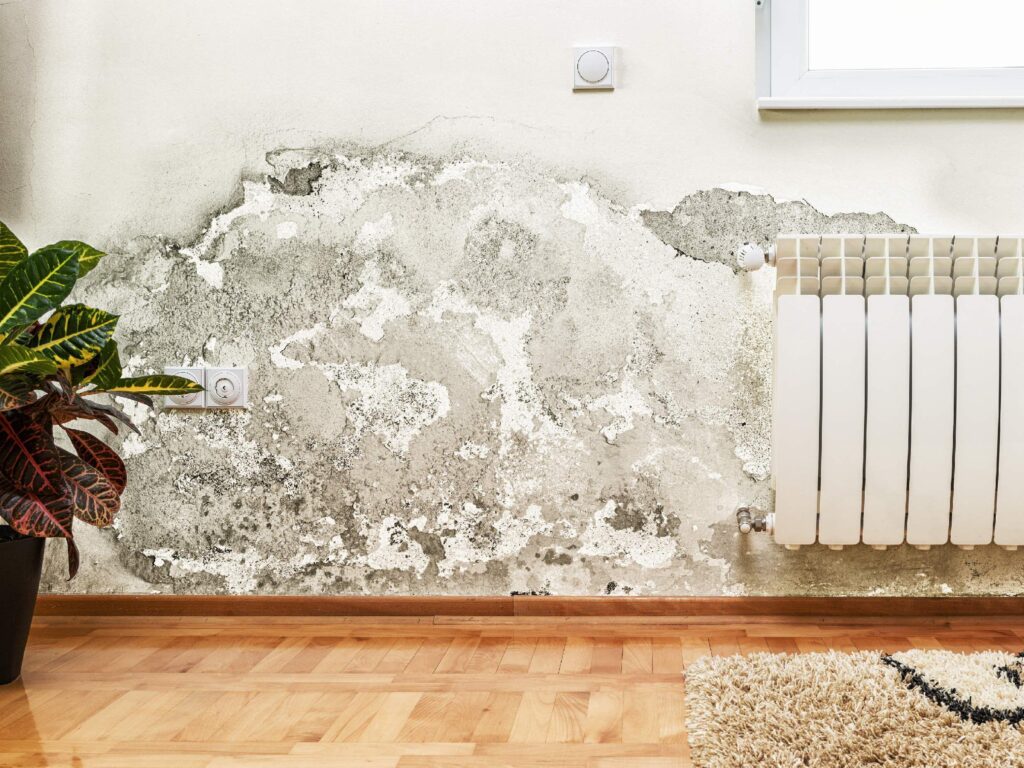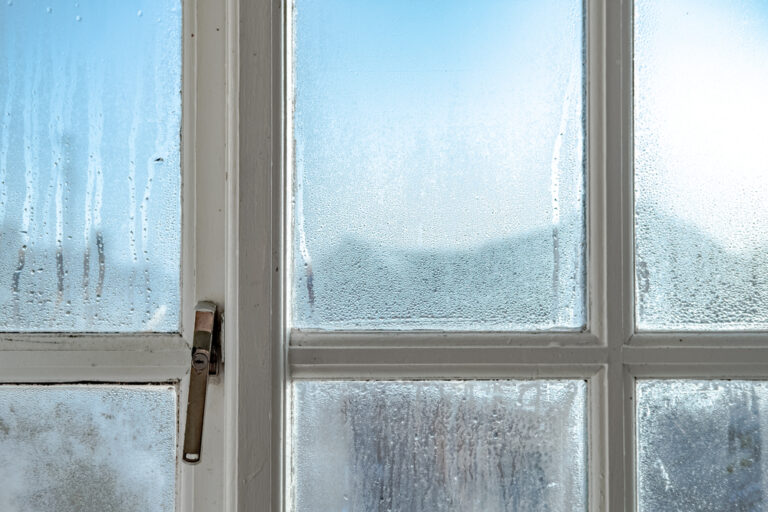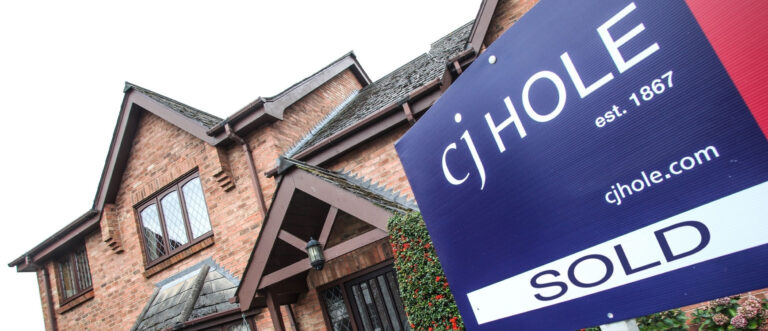Damp patches on internal walls can be hugely worrying for homeowners and landlords.
Not only does damp cause damage to the property itself, but it can also cause health problems for those living inside.
So, dealing with damp quickly and effectively is key – but where do you start?
This guide has all the answers…
What causes damp on internal walls?
There are three main types of damp found in residential homes – and the reason you’re seeing damp patches on your internal walls could be due to any of them.
1. Rising damp
Rising damp is caused when moisture can travel up from the ground through a property’s brickwork.
It’s more commonly found in older properties, where a damp-proof course (DPC) is either non-existent, has been breached or has become damaged through age.
DPCs are waterproof membranes installed between brickwork, around six inches above the ground and stop rising damp in its tracks.
However, DPCs didn’t become mandatory in construction until 1875 and weren’t always installed to the correct standard for a number of years after that.
So, if your property was built before 1875, it may not have a DPC at all – and even those built right up to the 1920s may not have an adequate DPC.
Rising damp can also be caused by a property’s external ground level being higher than the height of the DPC – a common problem when external building work like decking areas have been completed, or gardens built up.
2. Penetrating damp
Penetrating damp is when moisture and water penetrate a property’s external walls and creates damp on the walls inside.
While rising damp is often caused by problems with a damp-proof course (DPC), penetrating damp is more often the result of external structural defects, such as blocked or damaged guttering, cracked downpipes, a leaky roof or cracked pointing.
3. Condensation
Damp patches on internal walls may be the result of condensation – and this is one of the most common reasons for damp in UK homes.
Condensation forms when warm, moist air in a room touches a cold surface, such as an internal wall or window.
Excess moisture inside a property is more often than not caused by human habits – such as poor ventilation when cooking, bathing, or drying wet clothes on radiators.
However, poorly insulated, or badly heated homes can also face problems with condensation, too.
Spotting damp and correctly diagnosing it
The key to eradicating damp on internal walls is correctly diagnosing the problem and then taking steps to fix it.
Each type of damp problem has different tell-tell signs you should look out for.
Signs of rising damp
Rising damp is when moisture rises through brickwork.
Because of gravity, rising damp is limited in how far it can climb through masonry.
So, if you’re seeing damp patches on walls above a height of a metre, the problem is more likely to be penetrating damp or an issue with condensation.
Other signs of rising damp include:
- Yellow or brown patches appearing on walls
- Powdery deposits of salt on internal walls
- Flaky or bubbling plaster
- Peeling wallpaper or flaky paint
- Rotting skirting boards or flooring
- A damp, musty smell
What causes rising damp?
The most common cause of rising damp in older homes is a damaged, breached, or non-existent damp-proof course (DPC).
However, rising damp can also be caused by:
- The ground level outside your property being higher than the DPC
- The cavity between your external and internal walls being full of debris, which allows moisture to enter brickwork above the DPC
Signs of penetrating damp
Penetrating damp displays many of the same signs as rising damp – and is often incorrectly diagnosed as such.
However, penetrating damp often appears much higher up on internal walls than rising damp, which generally shows itself beneath a height of one metre.
If you’re seeing damp patches or damage to internal walls higher up, especially in corners where walls meet ceilings, or on the ceilings themselves, you could have a problem with penetrating damp.
Other signs of penetrating damp include:
- Blistered or bowed plaster or drywall
- Brown or yellow damp patches on internal walls or ceilings
- Damaged cornice and rotting timber
What causes penetrating damp?
Penetrating damp is usually caused by external defects, which allow water to penetrate external walls and cause damp on internal walls.
Those external defects could be:
- Cracks in walls, mortar, or render
- Broken or missing roof tiles
- Broken or ineffective roof flashing
- Damaged or blocked guttering
- Damaged or blocked downpipes
- Poor external fixings or fixings that are too deep
Signs of condensation issues
Condensation is one of the most common forms of damp in UK homes – and it’s easy to spot.
If you’re seeing water droplets forming on the inside of your windows, particularly during the colder months, you probably have an issue with excess moisture in your property.
Condensation can also cause damp patches on internal walls if they’re colder than the moisture itself.
Other signs of condensation include:
- Black mould growth on walls and around windows
- Mould growth on clothes or other fabrics
- Peeling wallpaper or discoloured paint
- A strong musty smell
What causes condensation in a home?
Most condensation problems in homes are caused by poor ventilation and human habits.
Because during the colder months we’re keen to keep heat in our homes, we often neglect to ventilate them properly – and all homes need to be able to breathe.
The biggest causes of condensation are:
- Poor ventilation when bathing or cooking
- Badly installed appliances like washing machines and dryers
- A lack of adequate heating
- Poor insulation
- External damage that allows cold air into cavity walls
How do you fix a damp internal wall?
The first step to dealing with any kind of damp issue is to find the source of the problem and fix it.
Once the overriding cause is fixed, you can then take steps to repair the internal walls affected.
Stopping rising damp on an internal wall
To fix an issue with rising damp, you should first work out what’s causing the problem.
This could be:
- An issue with the damp-proof course (DPC)
- A high exterior ground level
If the problem is due to the DPC, or a lack of one, the most common solution is to use a damp-proofing injection cream, which is inserted into the external walls through drilling holes in masonry.
The cream then cures to form a waterproof barrier, in the same way a traditional DPC would do.
If rising damp is being caused by the ground level outside your home being higher than the DPC, you may simply be able to lower the ground level by digging it out.
However, if you have an external construction attached to your home, such as a decking area, this may need to be rebuilt if it sits about the height of your property’s DPC.
Treating penetrating damp
To successfully treat penetrating damp, you should first establish what’s causing the problem.
Take a close look at your property’s exterior and look out for:
- Signs of damage to brickwork or masonry, such as cracks or missing pointing
- Damage or blockages in guttering or downpipes
- Missing roof tiles or damage to roof flashing
Once the problem has been identified, it can be fixed before any internal damage to walls is repaired.
Dealing with condensation problems
Although condensation can be a huge problem in homes, it’s easy to spot and easy to fix in most cases.
That’s because most condensation is caused by poor ventilation and habits.
To lower the moisture and humidity levels in your home, you should:
- Use extractor fans, or open windows when cooking or bathing
- Never dry clothes on radiators
- Keep doors open when sleeping to allow air to circulate
- Open trickle vents on windows
- Use a dehumidifier where required
Repairing internal walls affected by damp
Once the overriding issue causing your damp problem has been fixed, it’s time to repair the internal walls affected.
In serious cases of damp, your internal walls may need new drywall installed or a fresh coat of plaster before being decorated.
If the walls are salvageable, use a dehumidifier daily to fully dry out plaster or drywall.
Use a scraper or fine sandpaper to remove any flaky paint or plaster, before priming with a stain blocker to cover any patches.
Use a standard emulsion to paint your walls, applying at least two coats.





